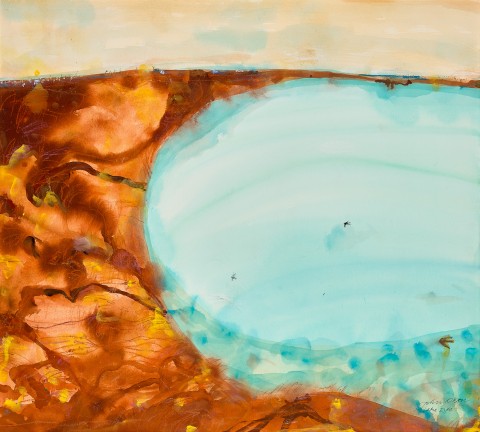Lake Eyre, c.1996
John Olsen
watercolour and pastel on paper
79.0 x 88.0 cm
signed and inscribed with title lower right: John Olsen / Lake Eyre
The Lowenstein Sharp collection, Melbourne
Deutscher~Menzies, Melbourne, 11 November 2002, lot 19 (as ‘Inland Lake’)
Private collection, Sydney
Olsen Gallery, Sydney
Private collection, Sydney, acquired in 2019
John Olsen Archive, Olsen Gallery, Sydney, 11 December 2019 – 1 February 2020, cat. 3
For many artists, there is a motif to which they return at numerous points in their career, reinterpreting and drawing new inspiration. For Sidney Nolan, it was Ned Kelly; for Paul Cézanne, Mont Sainte-Victoire. For John Olsen, the motif is Lake Eyre. Its significance is such that Patrick McCaughey has described it as being central to ‘four decades of Olsen’s Dreaming.’1 ‘I’ve been nearly drowned on the blessed lake when our boat sank in a sudden storm; nearly been sucked under by the quicksand-like treacherous black mud; nearly been blown away by winds that howl in at midnight, buffeting your tent; I’ve had desert sand blow into my eyes, my paint, the camp oven, and ruin my beautiful fish paellas... but all in all, I’ve had a fabulous time there.’2
Located 700 kilometres north of Adelaide, Olsen first visited Lake Eyre in October 1974 in the company of naturalist Vincent Serventy. They had journeyed to see the lake's largest flood in 500 years, an experience which profoundly affected the artist's way of interpreting his world. ‘The lake might be viewed as an unconscious plughole of Australia, a mental landscape... Because it is 13 metres below sea level – and perhaps nowhere in Australia does one have the feeling of such complete emptiness – covered by a bowl of endless sky with inviting silences, there is, as you stand on the edge of the lake, a feeling that you are standing on the edge of a void.’3 For Olsen, Lake Eyre was important both visually and conceptually, as a place of contradictions – of fullness and emptiness, life and death.
Like the artist Ian Fairweather, whom he greatly admired, Olsen was fascinated by Chinese art and literature, and found in the vast expanse of the lake a strong association with Sung Dynasty painting and the importance of space. Thus, in Lake Eyre, c.1996 he presents a perfect encapsulation of his artistic predecessors’ interpretation of the void as evoking the concept of ‘everything and nothingness’, ‘a place for contemplation, a vast, engulfing space.’4 Set on a highly tilted plane that may be viewed on a macro – and micro – level, the work captures that characteristic Olsen informality with the off-centre placement of the lake – a compositional device featured in many of his most iconic works, including Dark void, 1976 (formerly in the collection of the National Australia Bank) and Bathurst butter, 1999 (private collection) which Olsen presented as a gift to his wife at the time, Katherine Howard, on their tenth wedding anniversary.
Demonstrating Olsen’s brilliance as a master watercolourist, indeed the work dates from one of the most significant decades in the artist’s vast oeuvre – noted for the publication of Deborah Hart’s fine monograph in 1991 and his autobiography, Drawn from life in 1997, as well of course as the major retrospective exhibition hosted by the National Gallery of Victoria and the Art Gallery of New South Wales during 1991 – 92 which confirmed his enduring place as one of Australia’s finest artists.
1. McCaughey, P., Why Australian Painting Matters, The Miegunyah Press and Text Publishing, Melbourne, 2014, p. 236
2. John Olsen, cited in Hawley, J., ‘John Olsen’, Encounters with Australian Artists, University of Queensland Press, Queensland, 1993, p. 134
3. John Olsen, cited in Hart, D, John Olsen, Craftsman House, Sydney, 2000, p. 133
4. Hart, ibid., p. 135
ANDREW GAYNOR

